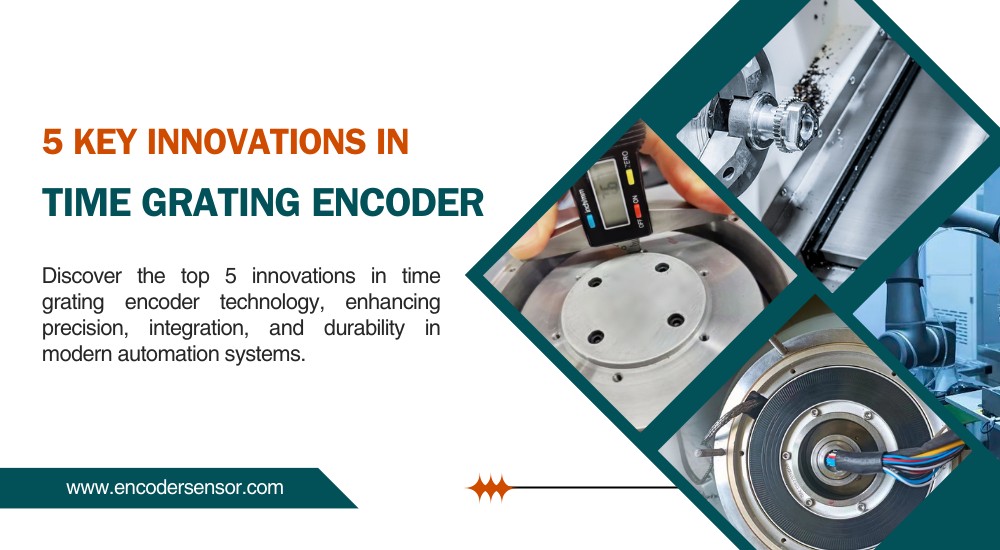Time grating encoder is at the heart of motion control and automation, offering exceptional precision and reliability. As industries demand faster systems, greater integration, and advanced feedback capabilities, time grating encoders are undergoing significant advancements. In this blog, we'll explore the 5 key innovations in time grating encoder technology and their implications for industrial applications, robotics, and beyond.
1. Advanced Signal Processing Algorithms
Revolutionizing Accuracy and Real-Time Feedback
Signal processing advancements in time grating encoders now allow for greater precision in data interpretation and system feedback. These algorithms are capable of:
- Eliminating Noise: Enhanced filtering techniques reduce interference caused by vibrations or external electromagnetic disturbances.
- Real-Time Error Correction: Algorithms can detect inconsistencies in signals and adjust outputs immediately.
- Smoothing Performance: Accurate position and velocity data ensure smoother motion in robotics and machinery.
For example, in aerospace engineering, high-speed applications rely heavily on faultless position readings. Advanced signal processing ensures the system operates at peak efficiency, even under extreme conditions.
Use Cases:
- CNC machines for ultra-fine cuts and etching.
Precision robotics requiring millisecond-level adjustments.
2. Integration with Industry 4.0
Smart Encoders for Connected Automation Systems
Industry 4.0 emphasizes interconnected devices and real-time data exchange. Time grating encoders are increasingly designed to function seamlessly within these smart systems. Features include:
- IoT Connectivity: Wireless communication protocols such as Ethernet/IP and Profinet allow for smoother system integration.
- Real-Time Monitoring: Embedded sensors provide performance updates, enabling predictive maintenance.
- Cloud-Based Data Storage: Encoders now store critical data in the cloud, supporting remote diagnostics.
This level of connectivity ensures that industries reduce downtime, optimize efficiency, and monitor performance without manual intervention. For example, manufacturing plants can analyze encoder health and prevent breakdowns before they occur.
Use Cases:
- Fully automated assembly lines.
Logistics warehouses utilizing smart conveyors and AGVs (Automated Guided Vehicles).
3. High-Resolution and Miniaturized Designs
Breaking Boundaries in Precision and Compactness
As machines become more compact and specialized, encoders must also adapt. Modern encoders feature both higher resolution and reduced form factors, ensuring they fit into tight spaces while offering impeccable precision.
Advancements in Resolution:
- Bit-Level Precision: Encoders now achieve resolutions of up to 36 bits, delivering unparalleled positional accuracy.
- Noise-Immune Encoders: Improvements minimize signal degradation even at high resolutions.
Compact Form Factors:
- Ideal for small-scale applications, such as lab equipment, surgical robots, and UAVs.
Examples in Industry:
In the healthcare field, surgical robots require encoders capable of pinpoint accuracy within incredibly tight spaces. Similarly, compact encoders power semiconductor production equipment where even minute errors can ruin batches.
4. Enhanced Environmental Durability
Robust Designs for Extreme and Harsh Conditions
Time grating encoders are no longer confined to controlled environments. Today, they are equipped to thrive under extreme temperatures, vibrations, and exposure to contaminants.
- Corrosion Resistance: Stainless steel and other non-reactive materials are used for casings, making encoders suitable for marine or chemical processing industries.
- Enhanced Enclosures: High IP ratings, such as IP67 and IP68, protect internal components from dust, water, and shock.
- Temperature Range: Encoders operate reliably in conditions ranging from -40'C to +85'C or higher.
Use Cases:
- Oil and Gas Exploration: With encoders exposed to drilling conditions, enhanced durability ensures consistent performance.
- Mining Equipment: Extreme dust levels and vibrations are no match for rugged encoder designs.
Outdoor Robotics: Withstands outdoor conditions like rain, humidity, or direct sunlight.
5. Multi-Functional Feedback Systems
Consolidating Position, Velocity, and Condition Monitoring
Modern time grating encoders are evolving into multi-functional feedback systems. These encoders no longer just measure position—they now offer additional capabilities that elevate their utility within automation setups.
Enhanced Feedback Capabilities:
- Position and Velocity Measurements: These systems provide real-time updates on speed and direction.
- Condition Monitoring: Encoders track internal parameters, alerting operators to signs of wear and tear.
- Customizable Feedback Loops: Encoders enable advanced control loops tailored to system requirements.
Advantages for Automation:
This innovation eliminates the need for multiple sensors, streamlining complex systems and reducing costs. For instance, autonomous vehicles now rely on encoders for simultaneous position and velocity tracking to improve navigation systems.
Key Benefits of These Innovations
For Industrial Applications:
- Increased Operational Uptime: Predictive maintenance powered by Industry 4.0-ready encoders reduces unscheduled downtime.
- Improved Efficiency: High-resolution designs ensure more accurate motion control, boosting productivity.
For Specialized Use Cases:
- Miniaturized designs open new possibilities in precision fields such as microsurgery.
- Durable encoders extend operational lifespans in harsh environments.
For End Users:
- Lower costs from reduced energy consumption and maintenance requirements.
Enhanced performance metrics for competitive advantage in production and automation sectors.
FAQs About Time Grating Encoder Technology
1. What makes time grating encoders different from other encoders?
Time grating encoders use unique timing technologies to achieve superior precision and reliability in high-speed applications.
2. How do Industry 4.0 innovations impact encoder systems?
Encoders equipped with IoT capabilities allow for remote monitoring, predictive maintenance, and real-time system analysis, ensuring maximum uptime.
3. What industries benefit most from these innovations?
Industries such as automotive manufacturing, aerospace, healthcare, robotics, and heavy machinery all see significant improvements in efficiency and accuracy.
4. Are durable encoders cost-effective?
Yes, although rugged encoders may have higher upfront costs, they minimize downtime and maintenance, offering long-term cost benefits.
5. Can modern encoders handle extreme environmental conditions?
Many encoders are designed with high IP ratings and enhanced materials to withstand extreme temperatures, moisture, vibrations, and more.
6. Are high-resolution encoders only useful for high-tech industries?
No, their applications span across industrial, medical, and even consumer products like 3D printers and drones.
Conclusion
Time grating encoders have entered an era of rapid innovation, blending advanced technologies, durability, and connectivity. These innovations are shaping the future of automation, allowing machines and systems to operate with greater precision, efficiency, and reliability.
By embracing these advancements, industries can gain a competitive edge and pave the way for a smarter, more interconnected future. Whether for industrial machinery, medical robotics, or aerospace engineering, time grating encoder technology remains a vital component of progress.
INQUIRY NOW

